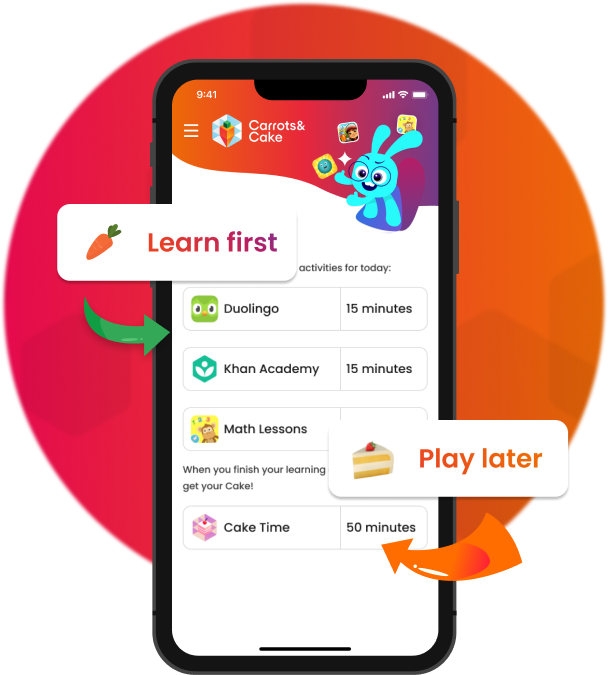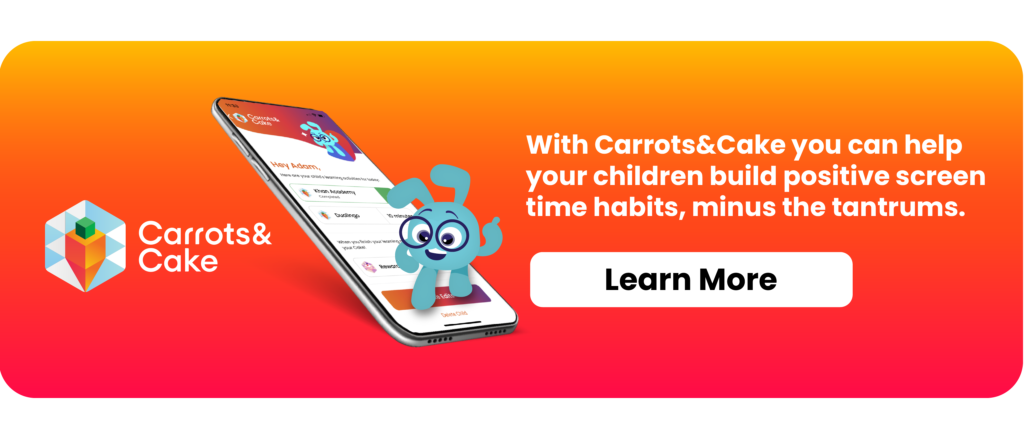


Most of us agree about life in the digital space; unplugging is not an option. But parents can ensure that we help our kids develop healthy, balanced screen time habits that allow them to become tech-savvy while developing into well-rounded and socially confident individuals by using the Screen Time Equation.
How do you ensure that a child’s screen time actively benefits them?
Carrots&Cake created a Screen Time equation to help parents map out the net benefit of screen time:

But aren’t screens bad?
Professor Dimitri Christakis, author of the American Academy of Pediatrics Screetime guidelines, conducted a study where he laid out six features and then compared traditional toys, television, and touchscreen devices to determine which was the most beneficial to a child’s development. He then came up with The Screen Time Equation.
Study Results:

Touchscreen devices demonstrated the largest benefit to aiding a child’s development.
Other studies have found that educational games and software increase learning success (Murphy, Penuel, Means, Korbak, & Whaley, 2001).
Mobile applications are particularly effective in enhancing literacy and developing math skills in children.
The effectiveness of educational apps can be limited, though.
The cons of learning apps:
Benefits of digital gaming
The equation also weighs in the benefits of digital gaming. Most parents think that video games that involve shooting guns (e.g., PUBG and Call of Duty) are detrimental to their kids.
But some researchers believe even these games have positive qualities. Shooting games can improve a player’s spatial skills. They help kids develop the ability to generate, retain, retrieve, and transform well-structured visual images.
An example of this is the ability to perform mental rotations in your head, visualizing objects from different perspectives and coordinating how to use one space in relation to another space (C. S. Green & Bavelier, 2012).
David Uttal, a professor at Northwestern University, found that players in shooting games demonstrated faster and more accurate attention allocation than their peers.
Alternatively, kids can sharpen their problem-solving skills by playing strategic video games. Set-ups that involve roleplaying, like World of Warcraft and Star Wars: The Old Republic, are helpful in these areas.
Engaging in video games can put players in a state of flow. This reduces boredom, depression, and anxiety. That doesn’t mean you should allow your kids unlimited video game time. Games need to be carefully managed to garner their benefits.
Harmful effects of digital gaming
Online games aren’t all good. This probably comes as no surprise.
Some behavioral deficits have been linked to excessive screen time (Ine Beyensa, Patti M. Valkenburga, and Jessica Taylor Piotrowskia).
Children are highly susceptible to the addictive traits of screen time. Their prefrontal cortex is still developing. This is the area of the brain that controls self-regulation.
At its extreme, internet addiction resembles drug addiction in terms of how the motivational system works. Both cases cause a person to lose the ability to self-regulate (Weinstein et al., 2017; Kuss et al., 2018).
Is there a relationship between screen time and displacement?
Screen time is not a substitute for socialization and play. While it’s important not to diminish the socialization that does happen on the screen, unless a child’s schedule has balance, screens do displace children from the real world and prevent them from developing formative stage skills.
Arrested development can be observed in children who spend most of their time on devices. These kids read at a lower level, have worse language skills, and display lower cognitive development as compared to their peers.
How can your family get the right balance of screen time?


Dr. Clifford Sussman, a child and adolescent psychiatrist and psychotherapist in Washington, DC, recommends young people incorporate healthy doses of activity into their daily schedule (equation).
These activities include:
Ages 6-12 years: 9-12 hours
Ages 13-18 years: 8-10 hours
What are HDAs and how do they matter?
HDAs are activities that result in continuous instant gratification. When children participate in them excessively, their brains become tired. The more kids play over time, the more resistant they become to dopamine. This means they require more stimulation in order to get the same level of pleasure.


Low Dopamine Activities (LDAs) result in delayed gratification.
Parents need to help kids find a balance between HDAs and LDAs.
Dr. Sussman suggests doing HDAs in limited blocks of time:
If there is time in a day for multiple HDA blocks, kids can develop delayed gratification skills by waiting at least an hour after completing an LDA before starting another HDA.
Our screen time solution:
Carrots&Cake has developed a science-based app to help parents make screen time scream-free, stress-free, and contract-free.
Learn First. Play Later.
Also Read: The Science Behind Carrots&Cake







